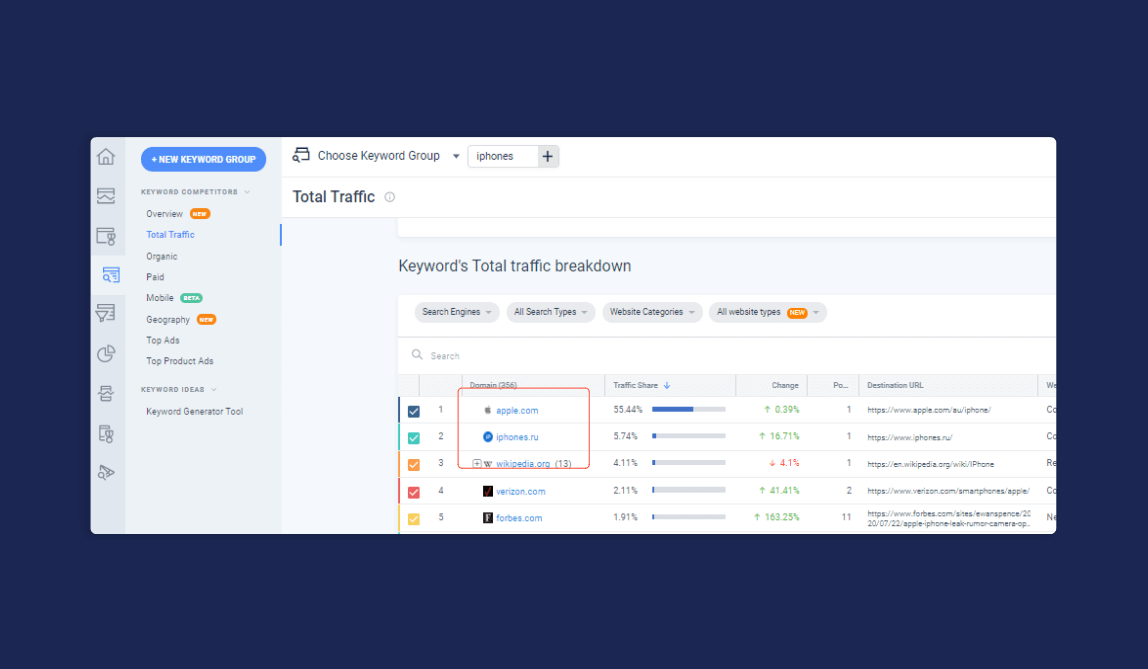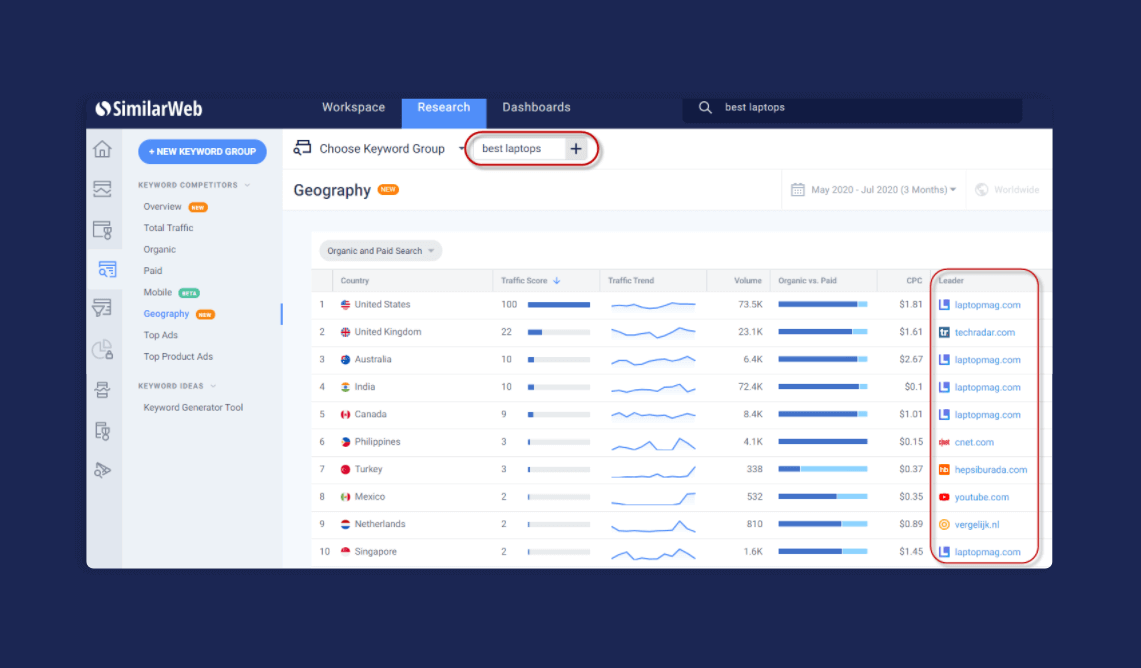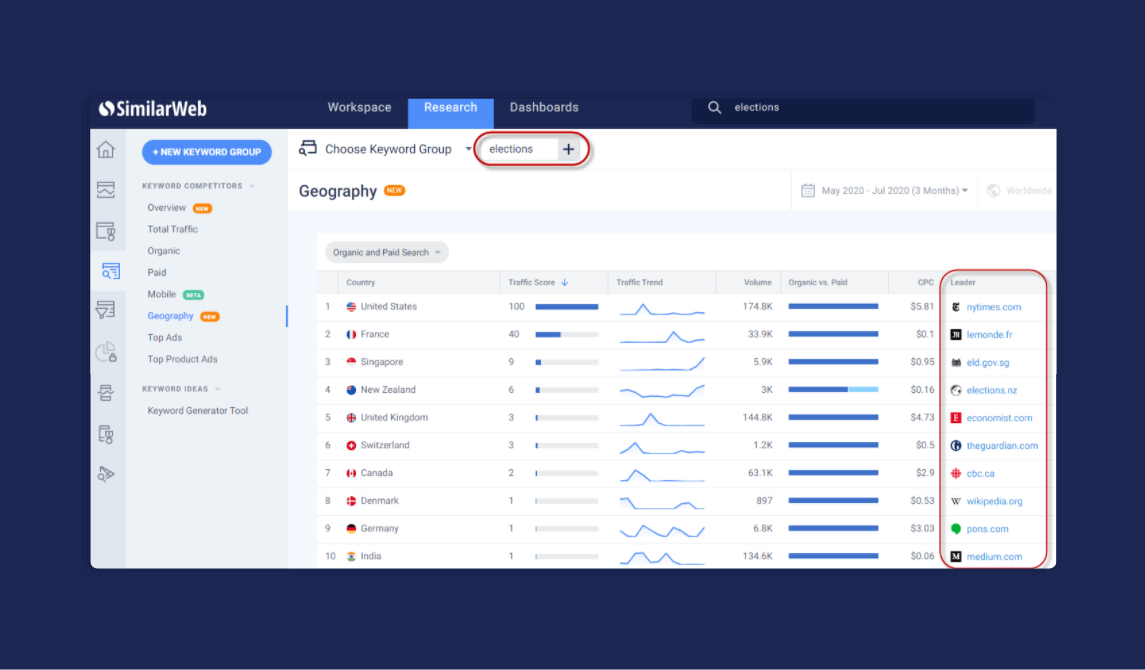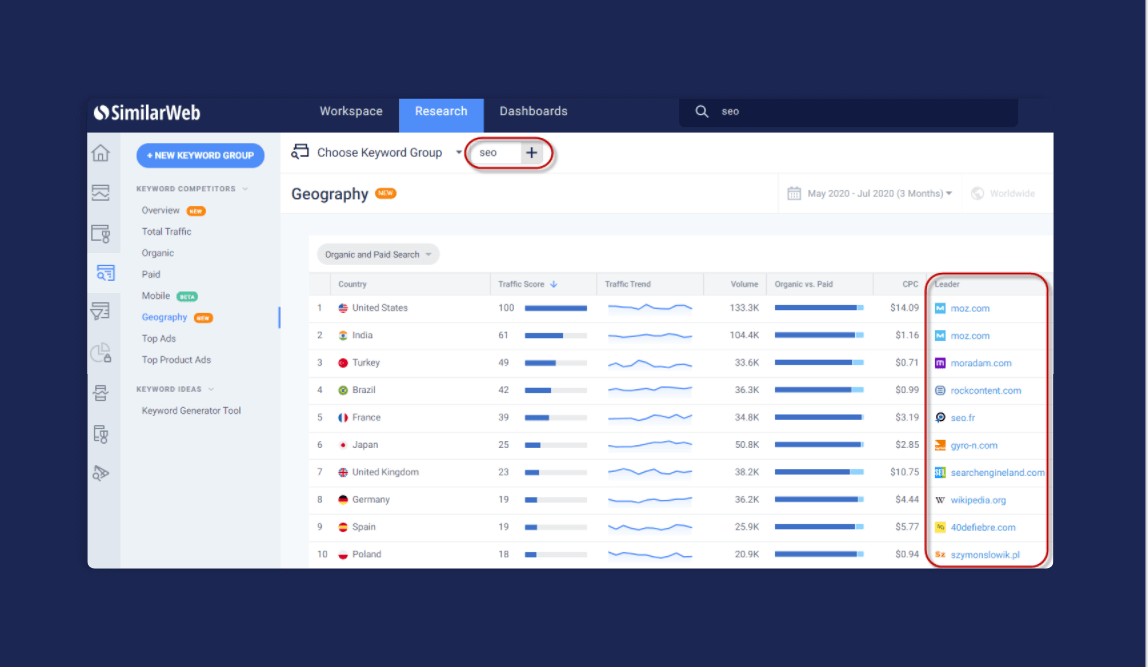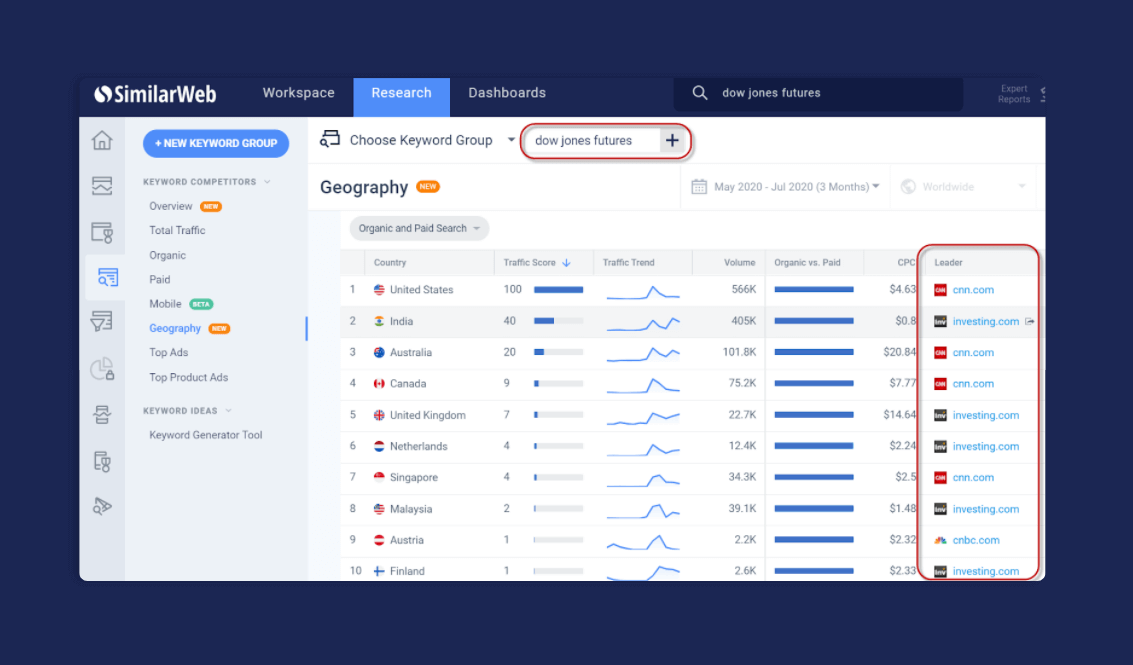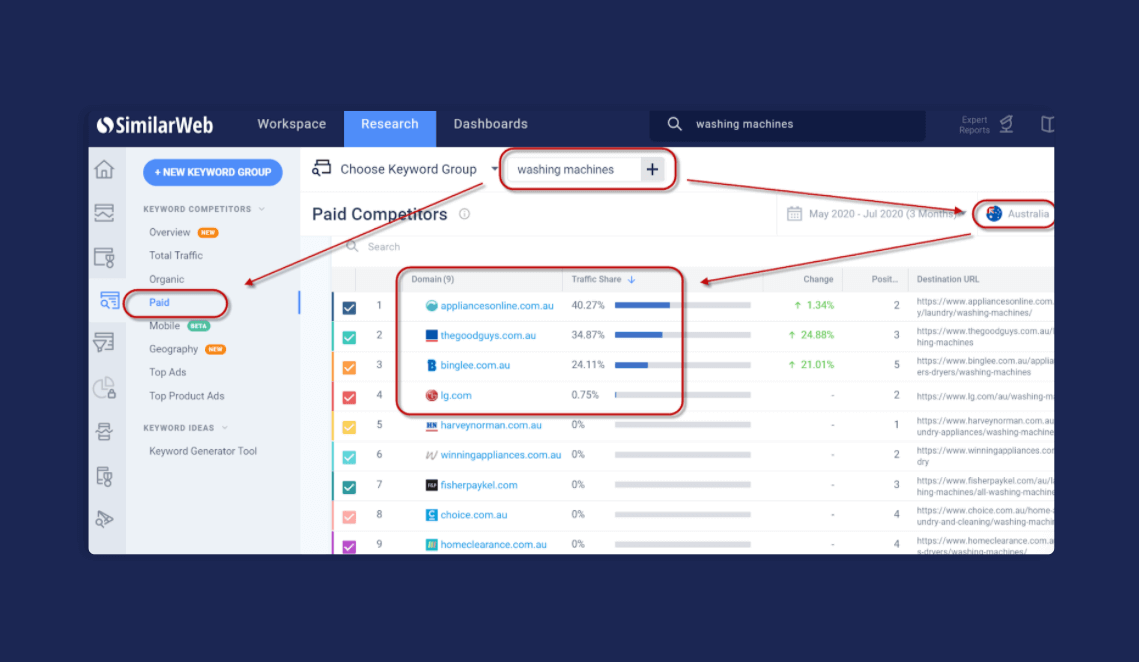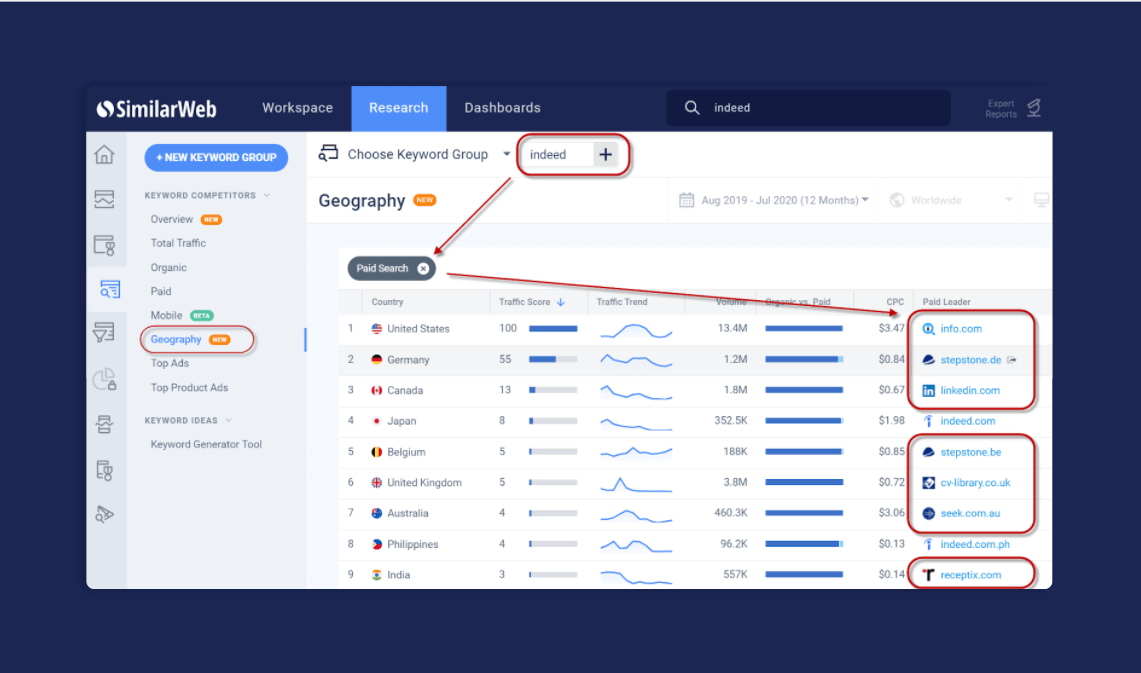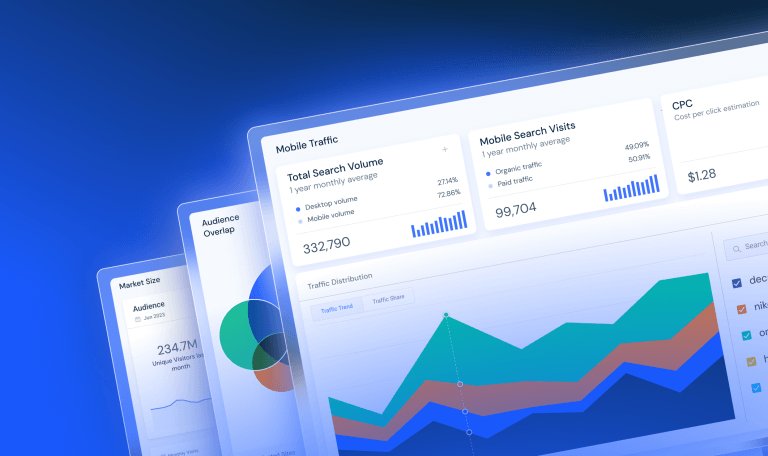Similarweb Now Lets You Analyze Keywords Geography Leaders
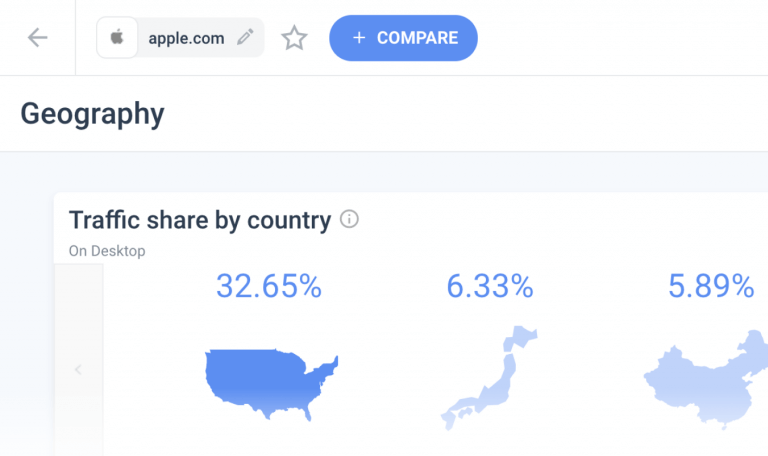
PPCs and SEOs, Rejoice! Similarweb Now Lets You Analyze Leaders per Country for Any Keyword.
SEOs and PPC experts are constantly striving to stay one step ahead of online trends, and of course, their competition. They need visibility into where markets are headed so they can optimize their campaigns in real time. This requires marketing intelligence that not only has the most up-to-date data but can also provide in-depth insights, such as keywords by country.
Until now, Similarweb’s keyword overview report showed at least one metric that other keyword tools never did: Traffic share per domain. That report shows a specific share of traffic for each of the results of each keyword in a given time frame.
This is a helpful feature for understanding your competitors’ and your industry’s top keywords, and how users choose their best results for queries you’re familiar with, as well as for understanding totally new keywords you’re interested in going after.
Now, there’s this new metric that drills even further, by showing us the leading domain for every keyword, per country as well as cost-per-click (CPC) and search volume per country.
None of us would be surprised that Google Maps ranks first for “Maps” in English in every country, but things are a little more complex for those queries that Google doesn’t dominate.
This new geo feature allows us to see which domain is dominating the search results as the traffic-share leader per country. It may help us understand our niche market significantly better, especially if we’re working internationally, and can teach us a thing or two about Google and how it matches intent with search results based on one of the most fundamental demographics: A user’s country.
What Can It Really Do?
Before we dive into specific examples of popular searches in different countries, let’s review what the product release can show you. The four main reasons you would want to use this new metric are to understand:
- Check overall traffic trends so you can figure out where you should focus your efforts right now in countries trending upwards.
- The distribution of organic versus paid search so you can gain visibility into how heavily saturated a market already is, and gauge how much you would need to invest in your PPC or SEO efforts in order to penetrate the market.
- The leading website so you can easily see who your biggest competitor is in each country.
- Organic and Paid filters which allow you to access all of the above benefits based on purely organic or paid search!
–Best laptops–
When people are searching for ‘best laptops’, their intent is quite clear. Show me lists of the best laptops I can buy now, or show me laptop reviews so that I can choose the best one for me. Not surprisingly, with a very clear commercial intent, this query is filled with ads.
In this case, one commercial site appears first in most English-speaking countries. Interestingly enough, while it has a separate URL for each country, and the right currency for every geo, the lists themselves are actually identical between all countries, offering the same laptops for people all around the world.
In the U.K., where Laptopmag isn’t the leader, it actually ranks with position zero (featured snippet). Seems that here, position zero gets less attention than the number one position.
–Elections–
‘Elections’ is another interesting local query, since in every country people refer to something else entirely. While the U.S. presidential election is one of the biggest events in America in 2020, the people of New Zealand have their own elections only two weeks prior to that, and in Singapore, they held their general elections in July. Same keyword, same language, totally different events.
–SEO–
Another interesting example would be an international word. SEO isn’t just SEO in English, it has the exact same meaning in every Latin alphabet language. In fact, it’s often spelled in English even in non-latin alphabet languages, such as Arabic or Hebrew. Just like stock symbols.
In this case, Google clearly takes into account the language before anything else and prefers sending the user to a local result about SEO, rather than a popular result in English.
–Dow Jones Futures–
A close competition between two domains in multiple countries may suggest that Google finds both sites very relevant, and makes the adjustment on a local preference basis. When checking the leader for ‘dow jones futures’, a popular financial term for the Dow Jones Index in general, and even more so during volatile markets as today – we can clearly see that Google has a dilemma between two domains.
How Can SEOs Leverage This Data?
Google’s search console can tell you where you rank for every keyword per country. This breakdown may help you understand your global average position better, and which countries exactly impact it the most.
When it comes to new keywords we’re considering, as SEOs we are looking for new opportunities to grow our site to new areas that are relevant for our business. Search volume is now just a tiny piece of the puzzle, as so many other factors impact the actual traffic you may be getting by ranking for a specific keyword.
Average click-through rate (CTR) for organic positions is a topic that has occupied SEO managers for a long time, but the truth is that it varies more on a single keyword basis, then on a keyword geography basis. Not to mention that two different users searching for the same keyword, from the same country, might get totally different search engine results pages (SERPs) and therefore, choose differently.
Checking a keyword’s Clicked ratio (vs. Non-clicked), then diving into the Total Traffic report and Traffic distribution between domains, can provide you with a much clearer picture of that CTR and the potential traffic from a keyword.
When adding a layer of how rankings vary between countries, we can understand Google’s preference for every single geo. And where would it be more feasible for us to actually get significant results?
Seeing the same Leader (the domain that gets the most significant share of the traffic) across all countries for a given keyword can tell us a lot about how strong that site’s dominance for a specific topic is globally, as well as about the difficulty to achieve high rankings for that keyword. Checking that same report with a longer period (for example 12 months vs. just three months), can confirm even further the stability of a domain for that query.
A much wider variety of domains between different countries, on the other hand, may indicate that the top results are slightly less stable, and may present a larger opportunity for new domains. That, of course, is as long as the query isn’t one with a local intent.
This should help you focus on more specific countries with your upcoming content and marketing activities around that topic.
How Can PPC Leverage This Data?
Generally speaking, PPC experts run campaigns on a specific country level. Since most campaigns lead to commercial deals, usually there’s focus on very specific countries per campaign. Because of that, for most cases, PPC experts would use the keyword geography filter, and look at the top Paid competitors.
In the example below, PPCs at LG.com might use this data to inform how they can improve their strategy for the keyword ‘washing machines’. Although they rank number four, they only account for less than 1% of all paid traffic to that keyword and might want to increase their ad spending or review their landing page content and UX.
For brands, on the other hand, the Geography report may show you which other brands are targeting your brand name, and highlight those countries in which a local brand is getting some of your potential users.
As shown below, Indeed.com has several other websites bidding on their brand name, and the sites doing so differ in each geography. That insight would allow the company to increase ad spend on their name in countries where they are concerned about the amount of traffic the competition wins off of it. Additionally, this tool allows them to benchmark how effectively they are protecting their name by monitoring the change in traffic share from the keyword ‘indeed’ over time in each place.
See it in Action
These insights are just a few examples of how this powerful tool can take your SEO and PPC strategies to the next level. To gain insight into your website’s keyword performance in relevant geographies, or that of your competitors, schedule a demo with one of our experts.
To learn more about how Similarweb can improve your business’s bottom line, check out our ebook, How to Build the Perfect Marketing Strategy.
The #1 keyword research tool
Give it a try or talk to our marketing team — don’t worry, it’s free!
